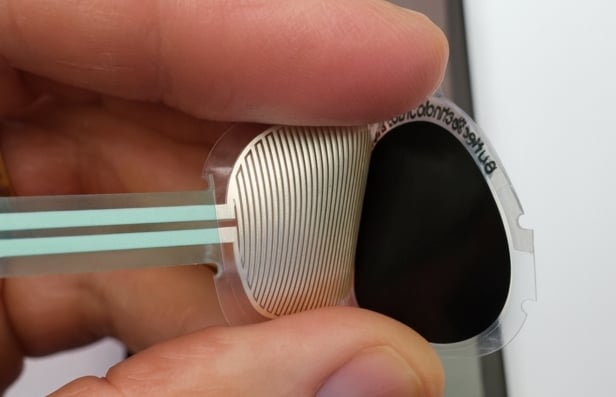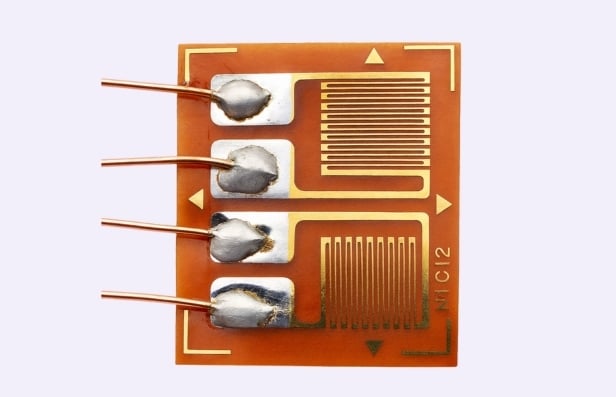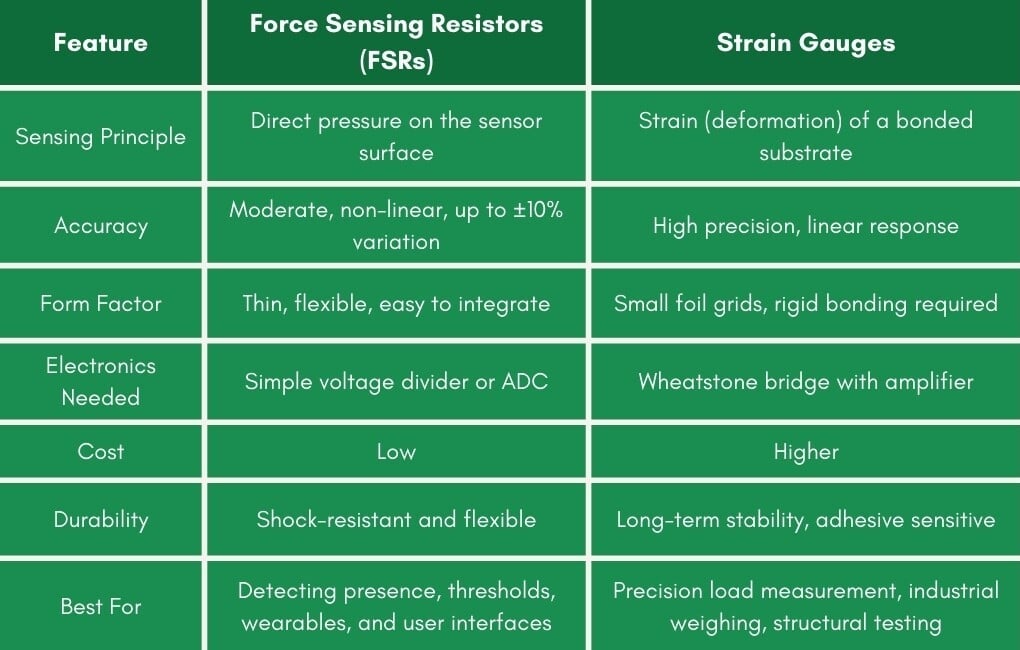When engineers and designers need to measure force, two of the most widely used technologies are force sensing resistors (FSRs) and strain gauges. Both convert mechanical input into electrical resistance changes, but their working principles, accuracy, and applications are very different.
At Butler Technologies, Inc., we manufacture custom printed electronic components, including FSR-based sensors, to help product teams choose the right sensing technology for their applications. Here is a detailed breakdown of how force sensing resistors compare to strain gauges.

What Is a Force Sensing Resistor?
A force sensing resistor (FSR) is a thin and flexible polymer-based sensor that reduces resistance when pressure is applied to its surface.
Working Principle of FSRs
FSRs use conductive ink layers separated by a spacer. In the resting state, the resistance is extremely high. When force is applied, the conductive layers are pressed together, creating multiple conductive pathways. As a result, resistance decreases and the output signal reflects the level of applied force.
Key Characteristics of FSRs
- Form factor: Ultra-thin (often <0.5 mm) and flexible, ideal for integration into compact or curved surfaces.
- Accuracy: Suitable for detecting presence, absence, and relative changes in force. Not ideal for high-precision measurement.
- Durability: Resistant to shock, bending, and repeated use.
- Cost-effectiveness: Low manufacturing cost makes them scalable for mass-market products.
- Electronics: Can be read with simple circuits such as voltage dividers, without requiring specialized amplifiers.
Applications of FSRs
- Wearable health and fitness devices
- Smart textiles and seating sensors
- Robotics grippers and haptic controls
- Touch-sensitive user interfaces
- Pressure mats and consumer electronics

What Is a Strain Gauge?
A strain gauge is a sensor made of fine metallic foil or wire arranged in a grid and bonded to a stable substrate. Instead of detecting direct pressure, it measures strain, which is the deformation of the material it is attached to.
Working principle: When the material stretches or compresses, the strain gauge foil deforms as well. This changes its resistance slightly, which is then measured using a Wheatstone bridge circuit for precision.
- Accuracy: highly precise and linear
- Requirements: careful installation, temperature compensation, and signal amplification
- Cost: higher due to precision design, adhesives, and electronics
- Durability: excellent for long-term load and stress monitoring
Applications: load cells, weighing systems, structural monitoring, and testing equipment.
Also, explore how to choose the correct adhesive for your application to better understand design considerations and selection criteria.
Working Principle of Strain Gauges
When the host material deforms under load, the foil pattern also deforms. This alters the resistance of the foil: stretching increases resistance, while compression decreases it. The change in resistance is very small, so strain gauges are used in a Wheatstone bridge circuit to amplify the signal and achieve accurate measurements.
Key Characteristics of Strain Gauges
- Precision: Extremely accurate and linear response to applied force or strain.
- Integration: Requires careful bonding, alignment, and calibration.
- Signal Conditioning: Needs specialized electronics such as bridge amplifiers.
- Durability: Long-term stable but sensitive to adhesive quality, humidity, and temperature.
- Cost: Higher overall cost due to complexity and precision requirements.
Applications of Strain Gauges
- Industrial weighing systems and load cells
- Force measurement in mechanical testing machines
- Structural health monitoring in bridges, buildings, and aircraft
- Precision medical equipment
- Robotics and aerospace engineering
Force Sensing Resistors vs. Strain Gauges: Comparison Table

Pros and Cons
Force Sensing Resistors (FSRs):
- Flexible, thin, and low-cost
- Easy to integrate with simple circuits
- Suitable for relative force detection
- Limited accuracy and repeatability
- Can drift with time and usage
Strain Gauges:
- Highly accurate and stable
- Industry standard for load and force measurement
- Excellent for critical applications
- Higher cost and complex electronics
- Requires careful mounting and calibration
Choosing the Right Sensor
Although both force sensing resistors and strain gauges translate mechanical input into electrical signals, they are built for very different purposes.
- Choose strain gauges if your application demands accuracy, stability, and calibration, such as industrial load cells, medical testing equipment, or structural monitoring.
- Choose FSRs if your design needs a thin, flexible, low-cost sensor to detect pressure or touch, where relative force measurement is acceptable, such as in wearables, robotics, and consumer electronics.
At Butler Technologies, Inc., we specialize in developing custom FSR solutions that provide flexibility, durability, and scalability. Our printed sensor expertise ensures that engineers and product developers can confidently integrate force sensing into innovative designs without compromising performance or reliability.
Making the Right Choice
Strain gauges and force sensing resistors both serve critical roles in engineering, but each excels in different areas. Strain gauges are indispensable for high-precision, industrial, and scientific measurements, while FSRs shine in consumer-focused, flexible, and space-constrained applications.
By partnering with BTI, you can access expert guidance and custom solutions that ensure the right technology is applied to your specific needs. Whether you require a highly accurate measurement system or a cost-effective force sensing layer, Butler Technologies helps you bridge the gap between concept and production.
